Aches and Pains? Essential Oils could help!
December is well underway. But with the festive season comes colder weather.
With the weather getting colder, our muscles tend to start tensing and stiffening up. Our body’s natural response to the cold is a process called vasoconstriction. During this process our blood vessels begin to narrow in our extremities and divert the extra blood to our vital organs (brain, heart, lungs, etc.) to keep them warm. When your muscles and tendons have less blood flow they begin to stiffen. However, not to worry because some essential oils have shown to have muscle-warming properties.
Essential Oils to help with aches and pains
- Black Pepper – this oil has shown to have warming, anti-inflammatory, and antispasmodic properties. It works to reduce muscle injuries, tendonitis, and symptoms of arthritis and rheumatism.
- Nutmeg – this oil could help to relieve muscle and nerve pain, arthritis, and gout.
- Cinnamon –this oil is known to possess antioxidant and anti-inflammatory properties.
- Cajeput – this oil’s therapeutic qualities include calming, soothing, and cooling effects. It has anti-inflammatory properties, and it can help to relieve aches and pains. It has also shown to be a good go to oil for respiratory conditions.
- Any of the Eucalyptus family – (such as Globlus, Smitti, Citordoria, Staigeriana, or Radiata). These oils can be powerful pain relievers and could help to reduce nerve pain. The pain-reducing properties of Eucalyptus essential oil can be attributed to the antioxidant and anti-inflammatory compounds in the oil. This has also shown to be another great choice for respiratory conditions.
- Ginger – This oil could help to alleviate joint pain and ease muscle stiffness. The Ginger essential oil has anti-inflammatory and analgesic properties. A review of the therapeutic properties of Ginger has found it is a natural remedy for rheumatoid arthritis, menstrual cramps, joint inflammation, and osteoarthritis.
- Rosemary – the analgesic and anti-inflammatory properties of this oil make it a great essential oil for chronic pain relief. This oil has also shown to be great for helping with memory.
How do I use Essential Oils for aches and pains?
There are several different ways to use essential oils in your home. Here are some suggestions on how to use the oils safely:
Massage
First things first, it’s a good idea to undergo a patch test. This can be done by mixing 1 to 2 drops of the essential oil with 10ml carrier oil. Apply a small amount to the unbroken skin on your forearm. If you do not react within 24 to 48 hours, it should be safe for use.
It is true, essential oils have shown to be used to reduce aches and pains. However, it’s important to note that they are very powerful and should NEVER be applied for direct use on the skin always mix with a carrier oil or lotion.
When massaging essential oils on your skin, you MUST dilute the oils in a carrier oil.
Common carrier oils include:
- Grapeseed
- Sweet Almond
- Coconut
- Avocado
- Apricot kernel
- Sesame
- Jojoba
Inhalation
If you have a diffuser, you can add a couple of drops of your chosen essential oil and inhale the steam. A carrier is not necessary for this method.
Essential Oils – Safety First!
It’s important to note that essential oils can be toxic for animals. If you have pets, just remember their sense of smell is between 1,000 – 10,000 more intense than that of a human. However, this doesn’t mean you can’t use essential oils if you have a pet. There are ways to get around this.
You should ensure your pet always has an escape route if the aroma is too intense for them. This could be in the form of an open door or window in the room where the oils are being used. With leaving the door to the room open at all times when the oil is being used, this allows your pets to be able to come and go as they please.

Always use caution when you are trying out a new oil. Take care to dilute your chosen essential oil in a carrier oil or lotion when applying direct to the skin and NEVER take any essential oil internally.
Speak to a qualified Clinical Aromatherapist before use if you:
- are pregnant
- have an existing medical condition
- wish to use essential oils on children or older adults
The potential side effects of using essential oils include:
- skin irritation
- skin inflammation
- sun sensitivity
- allergic reaction
When it comes to essential oils, less is more. You can always add to the blend but you can’t remove them. Depending on a range of factors from age, medical conditions, medication will determine how much essential oil is safe to use. Example of safe levels in 10ml or carrier oil/lotion is between 1-3 drops that’s all so I would recommend starting with the 1 drop and see how it suits you and your skin before thinking about increasing the drops.
If you are wanting to learn more about essential oils, their uses, blending techniques and safe uses for essential oils, then why not enrol in the next Level One Essential Oil Fully Accredited Course?
Keep an eye out on our socials for more information like this – Facebook, Instagram, and LinkedIn


